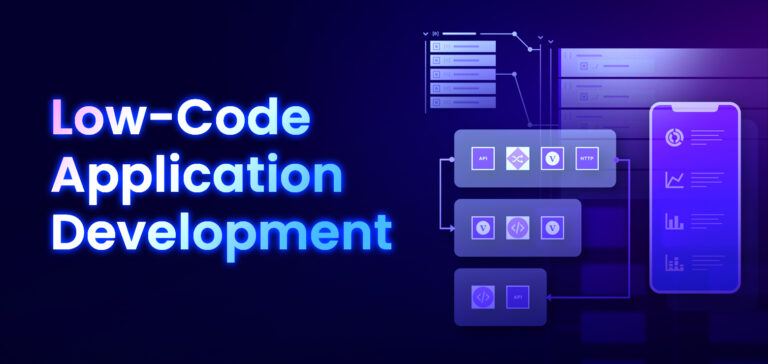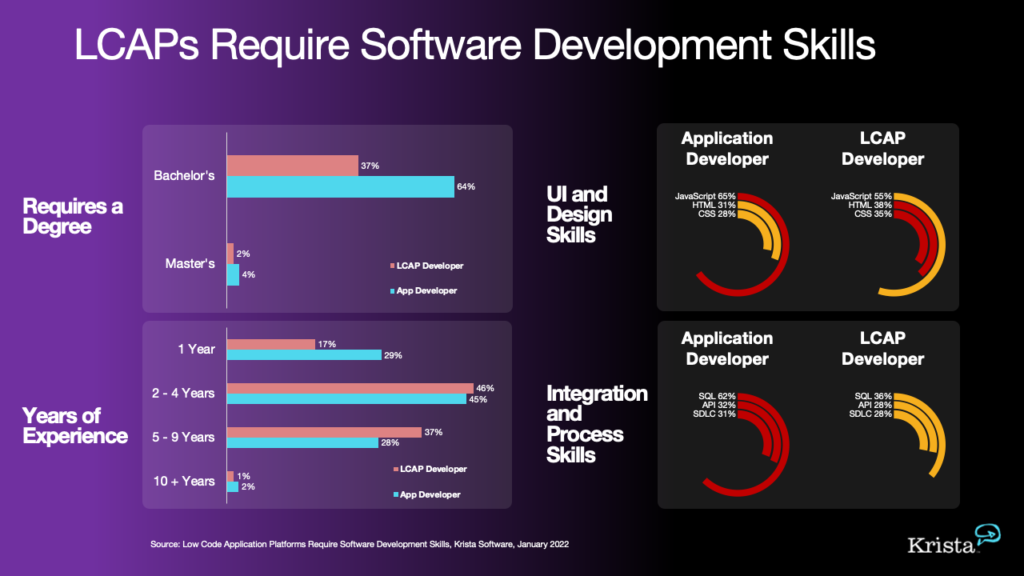Visual Development Environment :
Drag-and-Drop Interfaces: Low-code platforms provide visual tools for designing applications. Drag-and-drop components are a great tool for developers to build apps quickly without extensive code.
Pre-built Templates and Components: Many low-code platforms come with templates and components that are pre-built, which allow developers to rapidly create and prototype applications without starting from scratch.
Coding Requirements Reduced
Automated Generated Code: Lowcode platforms create the code base on the visual models created developers. This eliminates the need for manual coding.
Reusable Components: Developers can reuse components in different projects to reduce the amount of time needed to write and testing codes.
Collaboration streamlined:
Integrated Development Tools: Low-code platforms typically contain tools for managing versions as well as testing and deployment that allow seamless collaboration between development teams.
Citizen Development (Citizen Development) Developers and users of business applications can participate in application development making use of intuitive interfaces. This reduces the burden caused by a lack of professional developer availability.
Rapid Iteration and Prototyping:
Fast Prototyping: Developers can quickly design prototypes to validate ideas and gather feedback, which results in faster iterations.
Easy Modifications: The visual design of low-code programming makes it simpler to make modifications and updates to applications, which speeds up the process of improving and refining applications based on user feedback.
Pre-built Integrations:
API Integrations. A number of low-code platforms offer connectors built for well-known APIs and services. This can reduce the time to integrate systems.
Data integration tools: Tools to integrate data are integrated to make it easier for the process.
Deployment, scaling and deployment:
One-Click Installation: A lot of low-code platforms provide a single-click installation option that reduces the amount of effort and time required to set up applications.
Cloud-based solution: Cloud based low code platforms can handle infrastructure management and scaling. This lets developers focus more on application logic, functionality and features, rather than deployment logistics.
Low-code development of applications is a quicker method to create applications. It simplifies and automates many aspects of the procedure. This enables faster development and the ability to adapt to evolving requirements. Follow the best Low-code Platform for application development recommendations for website info including cloud software applications, rapid app development, cross platform app development, software for app development, build with docker, multiplatform mobile app development, cross platform mobile app development, jdbc server, app modernization, cross platform mobile development and more.

Benefits Of Low-Code Application Development In Governance And Security
Low-code applications offer a number of advantages in terms of security and governance. Both are crucial for ensuring that applications are compliant, secure and managed well throughout their lifespan. Here are the most significant benefits: Centralized Governance
Unified Manage Console: Lowcode platforms typically have a management console which allows administrators to supervise and manage applications.
Role-Based Access Control RBAC : These platforms typically have robust roles-based access controls, which permit administrators to define and enforce rules. This permits only authorized users to alter or access specific areas of the program.
Compliance and Regulatory Adherence
A lot of low-code platforms come with built-in conformity features. They are designed to comply with the requirements of industry standards and regulations, such as GDPR or HIPAA. They offer frameworks and tools to ensure that applications comply with requirements.
Audit Trails and Logging: Complete audit trails and logging are often combined, allowing businesses to monitor changes, track access and make sure that they are in compliance with internal and external regulations.
Increased Security Measures
Data encryption: Low-code platforms typically provide built-in encryption of data in transit and at rest. This ensures that sensitive data is protected.
Security Certificates: A lot of low code providers have security certificates (e.g. ISO 27001 and SOC 2) which demonstrate their adherence to strict security guidelines. They offer an additional security level to their customers.
Automated Security Updates
Regular Security Updates and Patches Low-code platforms handle automated security patches, updates and upgrades. The applications are thus protected from the latest threats without the need for manual intervention by developers.
Security Monitoring Tools: Tools for continuous monitoring of security are provided. They offer real-time alerts, as well as insight into security issues that might arise.
Data Governance
Data Access Policies: These software tools enable companies to establish the data access policies, enforce them and keep track of policies. This ensures that data is only accessible to authorized users and that they are used correctly.
Data Masking and Anonymization: The built-in tools to hide and anonymize data can help safeguard sensitive data when working in testing or development environments.
Consistent Application Management
Development and deployment pipelines Lowcode platforms usually offer integrated pipelines for development and deployment that include security tests. They guarantee protection throughout the lifecycle of the application.
Version Control: The integrated version control facilitates the control of changes. It also guarantees that all modifications to the software are tracked, and if needed, reversed. This ensures the security of the program.
User Authentication Authorization
Single Sign-On - Support for single sign-on (SSO) and other advanced mechanisms of authentication makes management easier and improves security.
Multi-Factor Authentication A lot of platforms have built-in multi-factor authentication, providing additional security when accessing apps.
Policy Enforcement and Compliance Monitoring:
Low-code platforms have templates for policies predefined and can help organizations implement governance policies and security policies.
Compliance Monitoring Tools: These provide continuous monitoring and report on the status of compliance. This helps to identify potential issues and take action to address them.
Integration with Existing Security Infrastructure
seamless integration: Low-code systems are designed to integrate with existing security software and infrastructure, including identity management systems and SIEM (Security Information and Event Management) solutions, and firewalls.
API Security: Integrated API security makes sure that integrations with an external system are secure. Protect data and maintain application consistency.
Best Practices and Training
Good practices: Several platforms provide guidelines for the development of secure applications and provide the best practices. This assists non-developers to comply with security standards.
Security Training: Certain providers of low-code provide education and resources in security that will help users understand how to design and develop secure applications.
Overall, the application's governance and security features guarantee that applications are developed and maintained in a secure manner while remaining in compliance with the regulations and in control. These platforms offer the frameworks and tools necessary to protect sensitive information as well as enforce policies and ensure regulatory compliance while simplifying the management and oversight. Have a look at the recommended Enterprise application development with Low-code Platform examples for website info including rapid applications, develop web app, application modernization software, rapid app development, rapid action development, rapid app development, azure sql databases, microsoft azure sql, azure sql server, develop mobile application and more.

Benefits Of Low-Code Application Development In Terms Of Limitations And The Possibility Of Customizing
Low-code application development is a well-balanced solution that provides significant benefits in dealing with limitations and permitting customization. These are the major advantages: Resolving the limitations
Overcoming Complexity Barriers
Low-code platforms facilitate development by providing pre-built templates and components. This allows faster deployment and the development of more complex applications.
Many platforms have wizards and workflows that are guided to help developers navigate complicated processes. These tools decrease the chances of errors, and help ensure the consistency of.
Scalability Solutions
Built-in Scalability: Low-code platforms have many features that support an architectural design that is scalable, allowing applications to cope with increased loads without major redevelopment.
Performance Monitoring: Integrated tools for performance monitoring and optimization can to ensure that applications are effective when they grow.
Security and Compliance
Integrated Security Features: Low-code systems have security features built-in like encryption, access control based on role and automated checks for compliance that address common security concerns.
Platforms regularly update their security protocols and ensure that they are in compliance with the regulatory requirements. This keeps the applications secure from threats that are constantly evolving.
Customization capabilities:
Extensibility:
Custom Code Integration: Low-code platforms typically permit the integration of custom code (e.g., JavaScript, Python), enabling developers to expand the capabilities beyond what is available in the standard features.
Developers can design custom plugins and modules which add features that are tailored to specific business requirements.
APIs and Integration:
API Support: A comprehensive support for APIs facilitates seamless integration with other systems and services, which allows for customizing and connectivity.
Third-Party Services: Low code platforms offer connectors that are pre-built for popular third-party services. This makes it much easier to build and integrate applications.
Flexible Design for UI/UX
User-friendly interfaces with customizable options: Users can create and customize their own user interfaces, that will give an experience that is more customized.
Responsive Design: Built-in adaptive design capabilities make sure that applications can be tailored to fit different sizes of screens and devices.
Custom Business Logic:
Visual Workflow Builders: Visual tools for designing and customizing workflows and business logic allow developers to create complex, tailored workflows without programming.
Platforms can be equipped with conditional Logic which permits the development of custom scripts to address certain scenarios or business rules.
Data Management
Custom Data models: Developers are able to design a custom data model that meet the specific requirements of an application and ensure that data handling complies with the requirements of business.
Advanced Data Processing: Integration of advanced data processing tools and capabilities allows for customizing the way that data is analysed and used in the application.
Balancing Customization with Limitations
Frameworks and Standards
Low-code platforms encourage industry best Practices and Standards: Low code platforms encourage adhering to industry-standard best practices and standards. This makes it easier to maintain high-quality, secure, and flexible applications.
Governance Frameworks - Built-in governance systems ensure that customizations don't interfere with security, integrity or the observance of regulations.
Iterative Development:
Rapid prototyping: By being in a position to quickly prototype and test customizations developers can iterate on the feedback of users to improve the application.
Low-code platforms have been designed to enable continuous enhancement. This permits for modifications and enhancements as business requirements evolve.
Empowering Users:
Giving Citizen Developers the tools they need In allowing non-developers customize their applications using simple user interfaces, platforms that do not require code increase the pool of contributors who can improve and customize applications.
Support and Training Information: Many platforms offer extensive training and support materials to allow users to customize their applications without jeopardizing their functionality or stability.
Low-code applications offer a flexible framework that can be customized to meet the specific requirements. This allows companies to create and maintain functional apps that are tailored to their specific needs, while maintaining high standards for quality, security and scaling.
